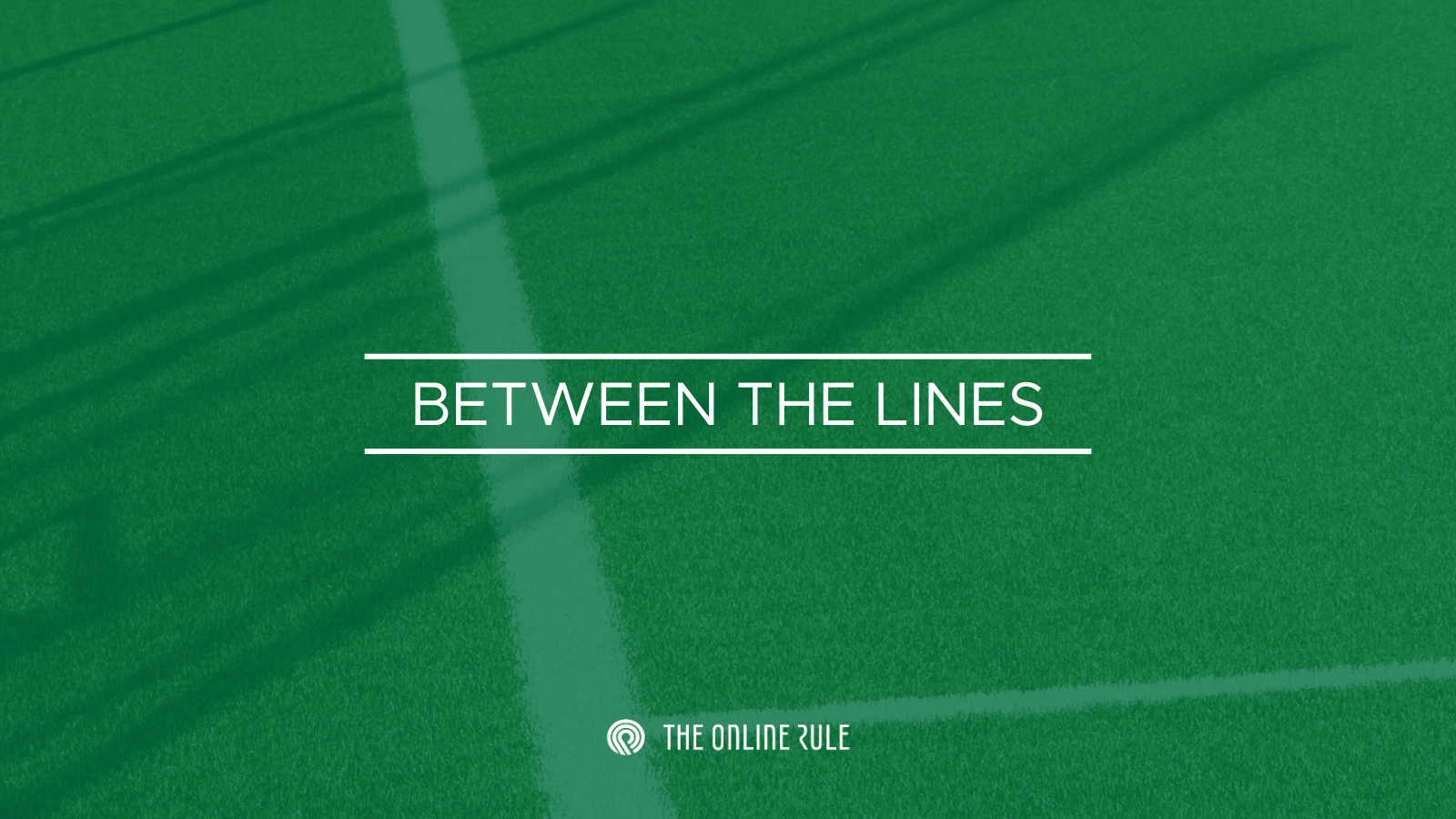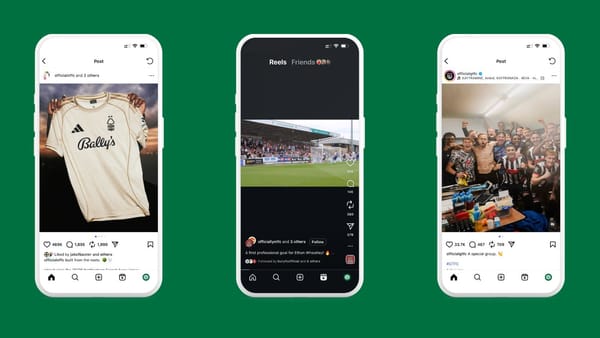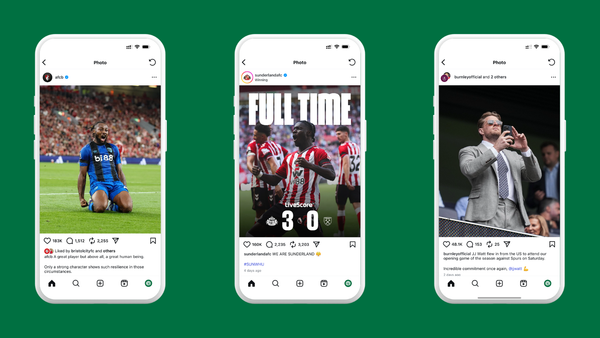Why aren't more teams making the most of email marketing?
I visited the websites of the top 92 English clubs and tried to sign up to their mailing lists so that you don't have to.
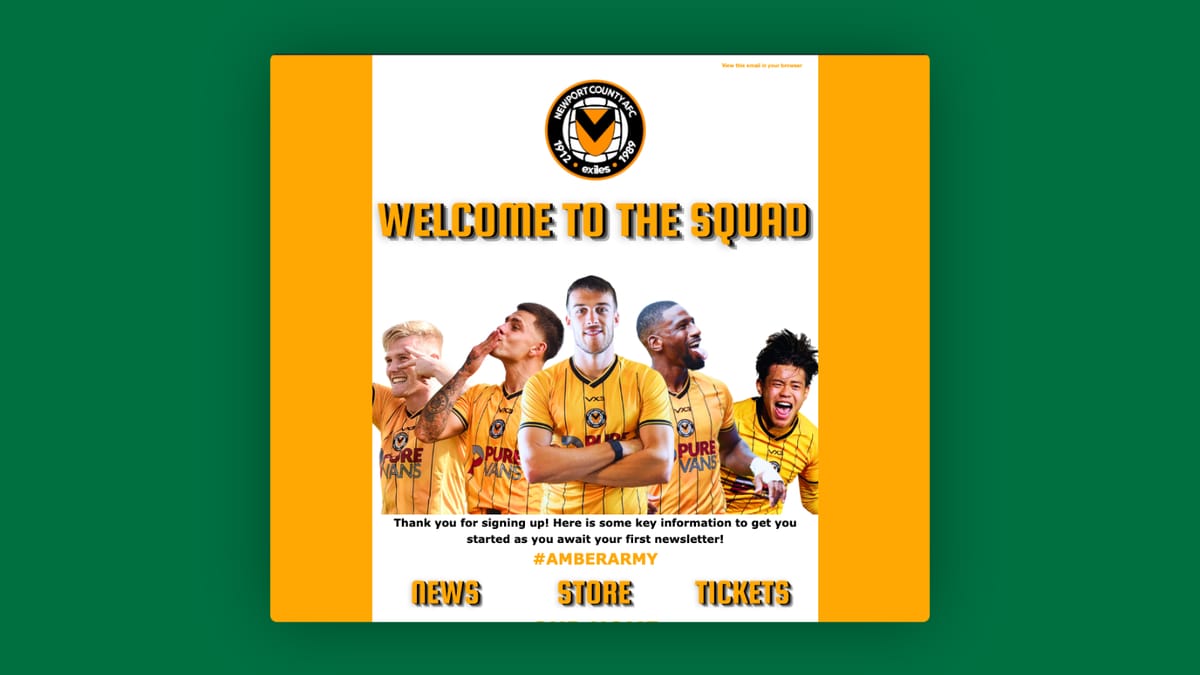
I haven't done this, but I guess that if you ask everyone who works in marketing what their favourite marketing channel is email won't feature high in the list.
Podcasts are trendy. Social media gives you instant gratification. Videos look great. A lot of the 'action' with email happens behind the scenes. Nobody reacts to them in real-time, people rarely respond to them, and I can't remember the last time a friend shared one with me.
Yet they remain a reliable source of conversions. And open rates have never been higher in the last 20 years.
Statistically it's better to trade 1,000 new followers for a single email subscriber.
According to Mailchimp, emails from sports businesses see an average open rate of 41.84%. That's you. And the highest unsubscription rate from any industry is 0.37%. That's tiny.
I spoke to a few clubs about their figures and what they can attribute to email marketing in tools such as Google Analytics 4 (which will tell you where your customers came from), and email marketing was consistently the third or fourth highest converting channel. Typically it ranks behind direct traffic (people typing your web address in), organic search (people using Google or other search engines), or occasionally behind paid search depending on the advertising budget (where people are paying to advertise in a search engine, usually Google).
You can't find any specific figures about how many people see social media posts. It changes depending on the team involved, and other factors such as performances and results. However, it's hard to find any estimates higher than 10%. And then there are considerations like the algorithms.
So I thought it would be useful to look at how the top 92 clubs in England are using email newsletters. I've also provided some advice if you're thinking of changing your newsletter platform.
How is email marketing being used?
On Tuesday 5th March I visited the websites for all 92 clubs across the Premier League and English Football League. I was looking for a few things:
- Was it clear how to sign up to their email marketing?
- Where do clubs have their sign-up forms?
- Did I receive a welcome email after signing up?
I limited my search to each club's home page and main navigation. I figured if it wasn't in either of those places then it wasn't a priority for teams, and that fans also wouldn't be able to find it.
I also only counted clubs where they specifically state that you're signing up to receive regular emails. Quite a few bundle newsletters in with wider digital accounts that give you access to ticketing and video content. I only signed up for these if one of the benefits listed was being part of an email list. And I only clicked to find out about the accounts if there was a relevant call to action, such as "subscribe" or "sign up". I didn't if the buttons said "register" or "create account". So there are some judgement calls being made here. I tried to keep it as close as possible to how I would expect regular fans to interact with websites.
NB: As ever, I'm only going to name the good examples of what I found. I'll keep everything else anonymous. If you work for a team and want some specific advice about the experience of signing up for your newsletter, reply to this from your club email address and I'll happily send you my notes.
Firstly, I managed to subscribe to 46 mailing lists. That's slightly over half. Technically I subscribed to 48, however after signing up to what one club said was an email list I received a confirmation email with a supporter ID number and information about my new ticketing account. The other club thanked me for submitting my entry and said they would be in touch if I was successful. I'll let you know what I win.
Out of the clubs I didn't manage to subscribe to, a lot of these were because all of the registration page only talked about exclusive video content and other perks. So it wasn't clear enough that there even was a newsletter. Thing is, I know plenty of other clubs send out weekly emails as I've worked with some of them. But it doesn't appear like encouraging sign-ups is a priority.
I'm hoping this convinces you otherwise.
One club's sign up form went to a 404 page (since corrected), and one other gave me an error each of the five times I put my email address in so I gave up.
What's the most popular way to drive subscriptions?
A lot of clubs in the Football League are using the league's standard template design. This is a rigid design, so the clubs using this have fairly consistent approaches to subscriptions.
Here's how Crawley Town's website, chosen at random, uses this approach.
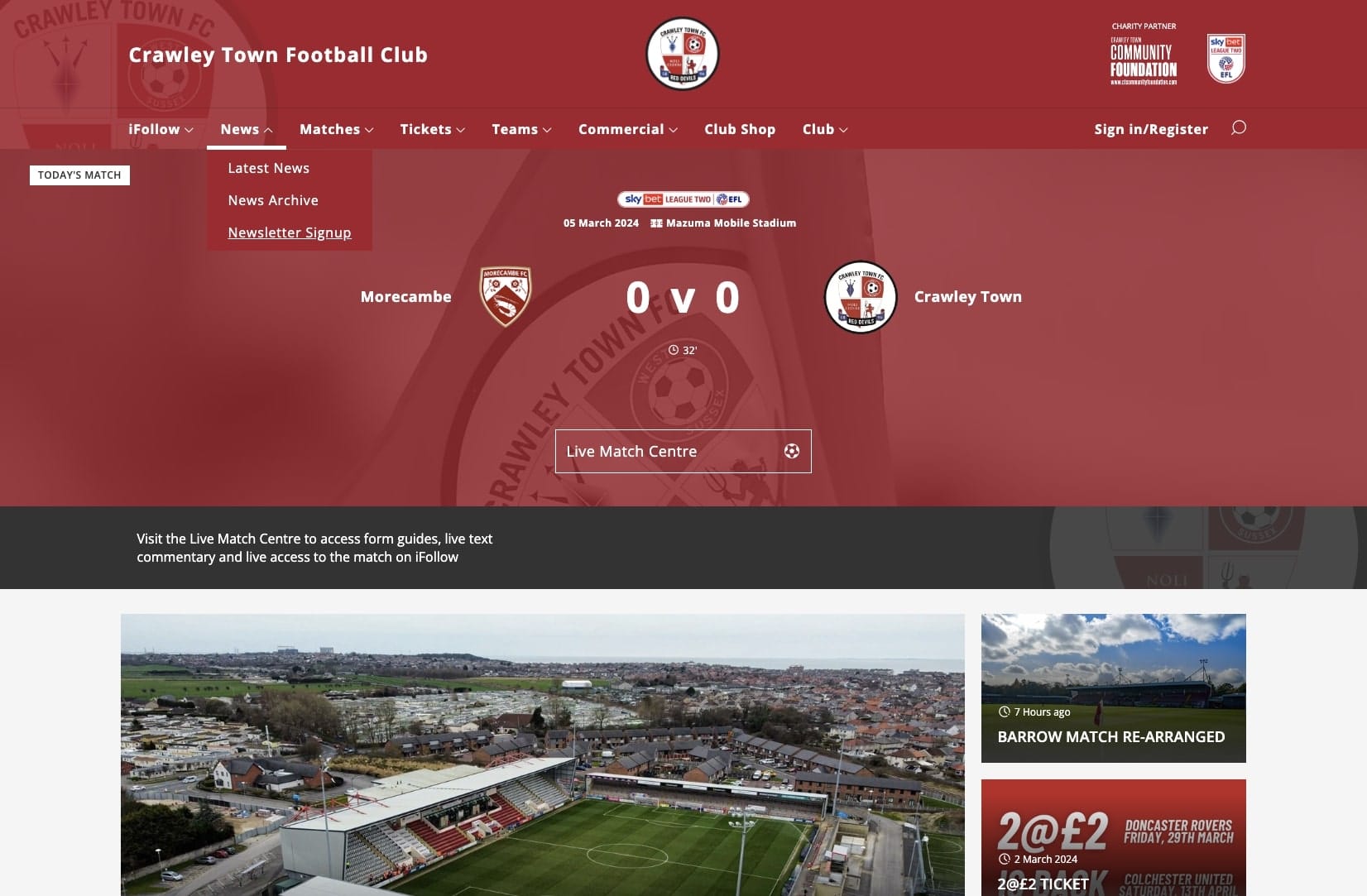
You can see from the menu that there's a 'newsletter sign-up' option. This was the preferred method for 31 of the 92 clubs I looked at. It's an automated newsletter that picks the top stories from your website and sends them out every week - very low maintenance, and part of the existing digital contract that some EFL clubs are subscribed to. This deal expires at the end of this season, so we can expect to see more varied approaches in future.
Clubs do have the option of setting up their own solutions, but understandably these come with higher set-up and maintenance costs. When you have a smaller marketing team and a wide range of responsibilities, knowing the website and newsletter is being dealt with is quite reassuring. I do think the newsletter, at least, should be given more importance.
If I was at a club that used the standard EFL solution, I would absolutely be prioritising creating my own list of subscribers and having full control over what gets sent out and when.
What I did find interesting was that despite using the same template, AFC Wimbledon have a pop-up on the homepage that lets you sign up.
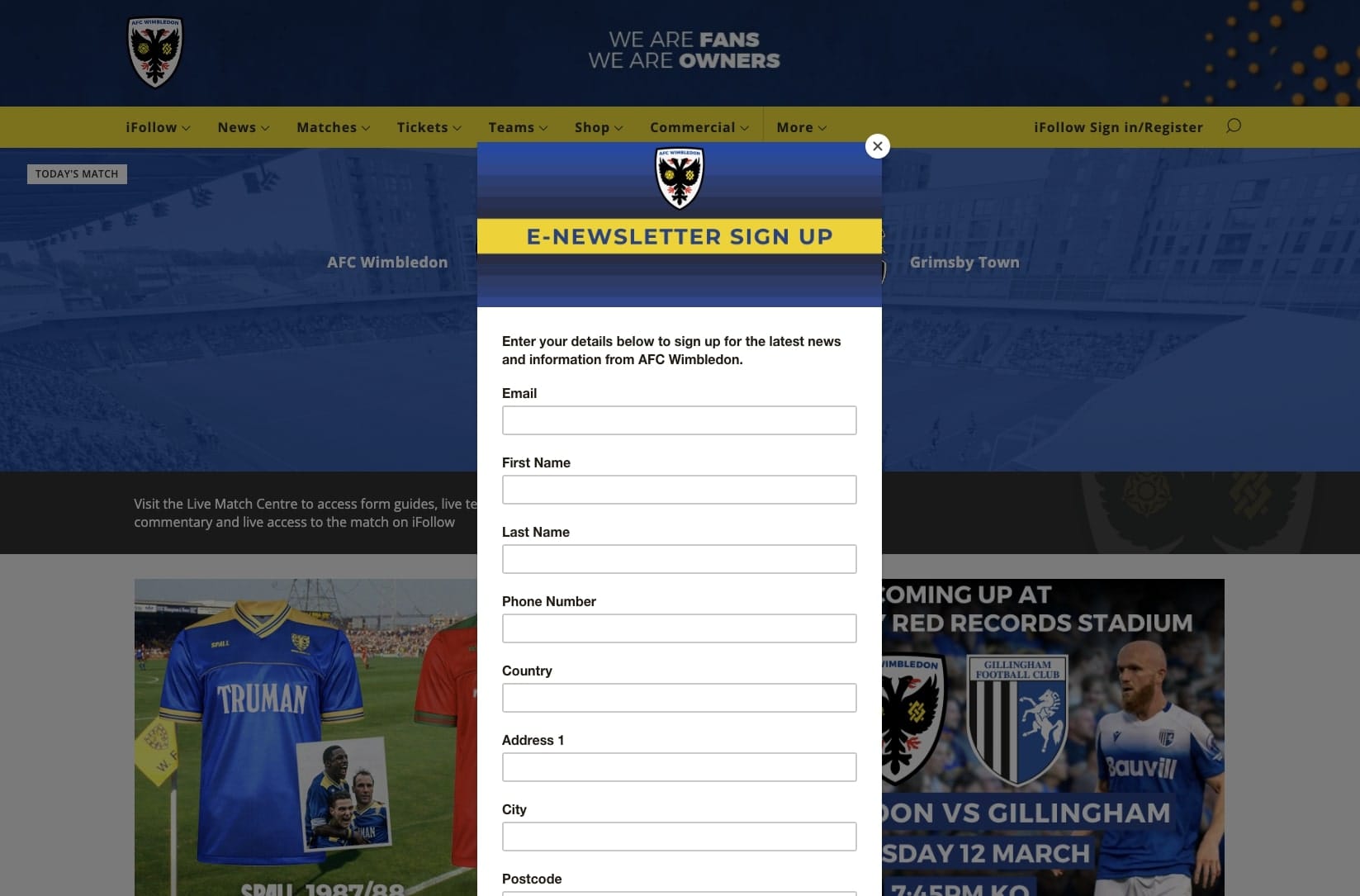
Only two clubs out of the whole 92 use the pop-up approach. Wolves are the other one.
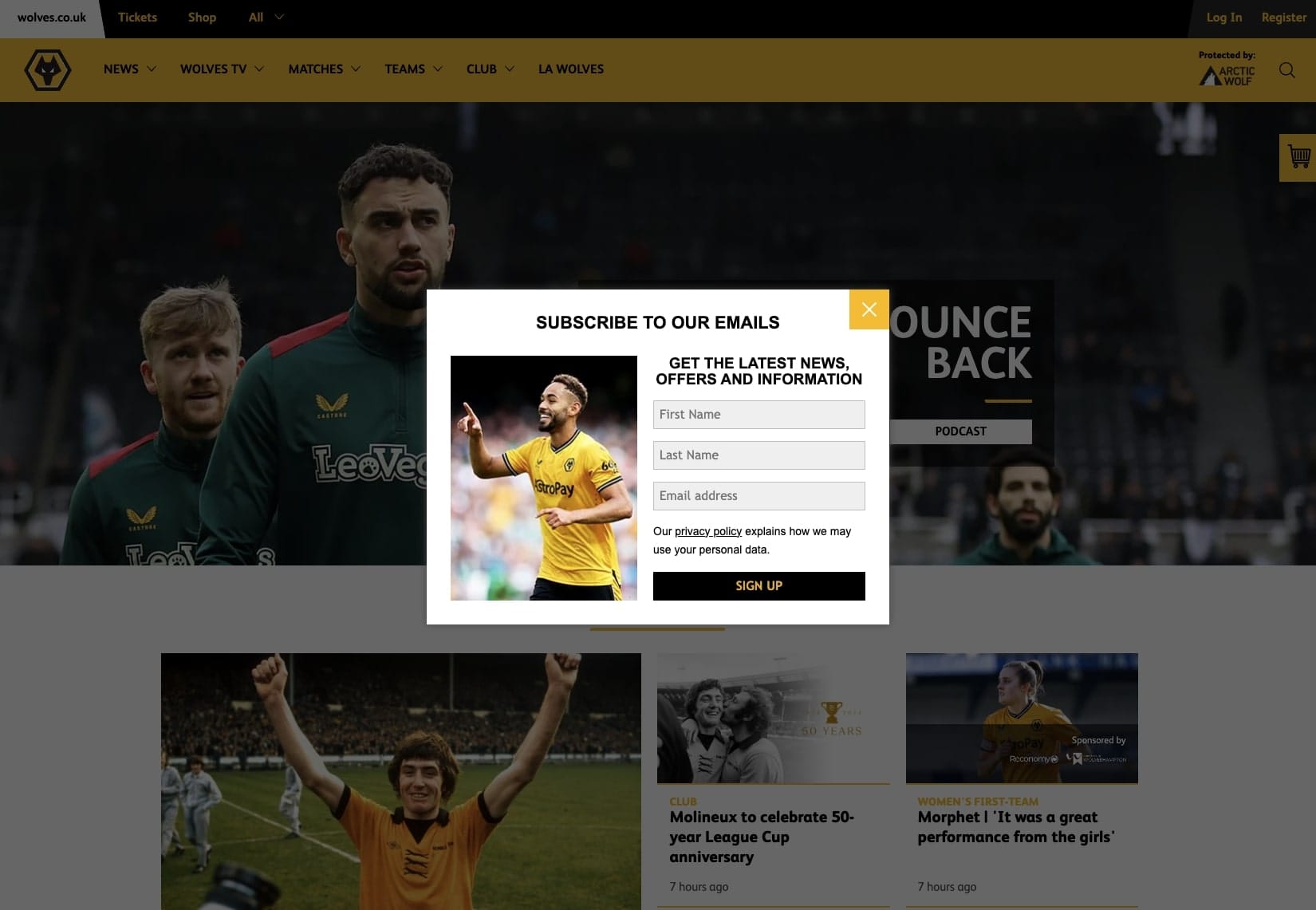
Pop-ups are an effective way of encouraging sign-ups to a newsletter list. You've got a good idea that they're interested because they're on your website, and you know they're going to see it.
Other clubs use pop-ups, but they're carrying sales messages instead. They may use email messaging at other times of the year.
The next most popular approach was to carry a subscription message or form in the footer. Probably the most common place for any other type of website. This is where eight of the 92 put their prompts, with Wolves the only team who had their form in two places (pop-up and footer).
Here's how this looks on Stockport County's website.

You can't miss that nice big yellow button (which is on brand too).
For messaging, I really like Burnley's wording. I'd argue that it's maybe not the clearest so that you know what you're signing up for. Hopefully nobody's made the mistake of thinking they'll be turning out for the first team.
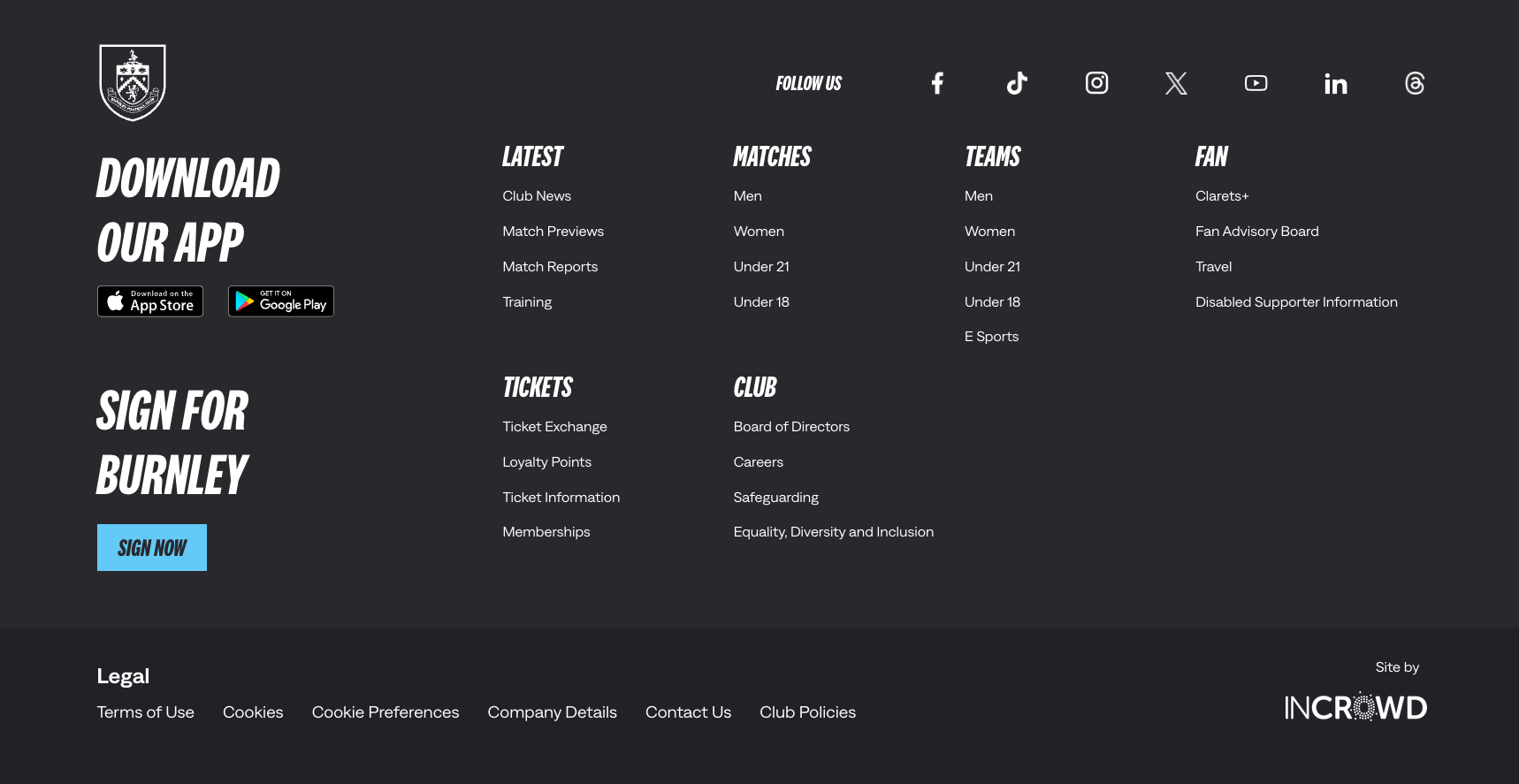
All told, only 10 of the 92 teams I looked at featured a prominent way of subscribing on their home page, whether that's through a big button or an embedded form (I didn't include the ones in menus in this number as the option is slightly hidden).
And a final shoutout to West Bromwich Albion, who are the only team to feature a subscription button in their header.
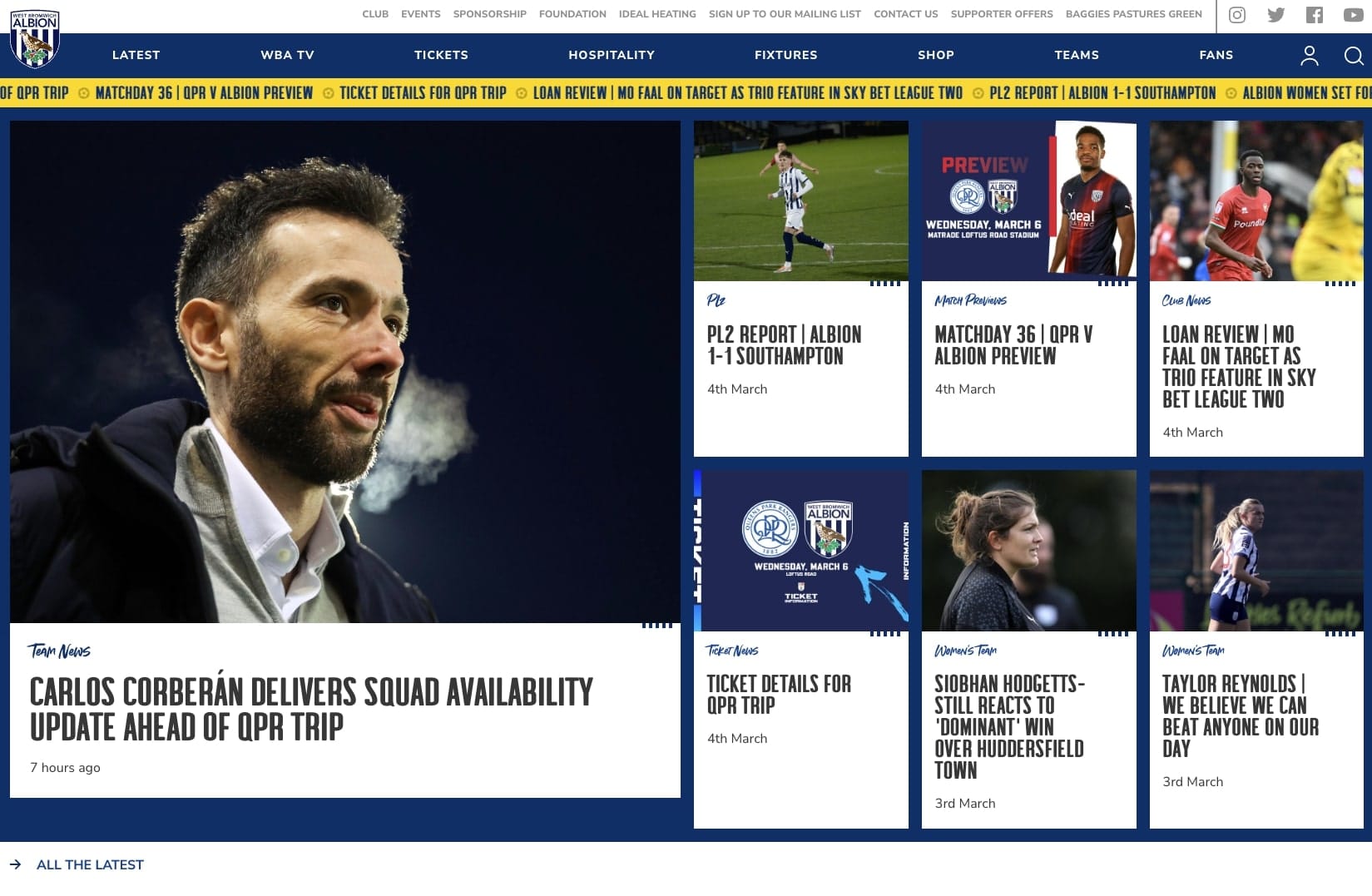
What happens after you sign up?
After signing up, I expected a deluge of emails from clubs welcoming me on board.
I received six in the first 24 hours.
Because there aren't many, I can list them:
- Bristol Rovers.
- Brentford.
- Newport County.
- Stevenage.
- Wolves.
- Wrexham.
NB: I covered Charlton's great welcome email on X, however it's generated after subscribing for a ticketing account rather than signing up to a newsletter.
The purpose of a welcome email is to keep people 'warm' after subscribing. It's a point when they're likely to be fairly engaged because they've signed up, and you'll be front of mind already when the first email lands. Also, if you only send out a weekly update, it's a way of filling the space between them if they sign up five days before the next one is due to arrive.
There were some fantastic examples here. Quick word of warning: there are some big and lengthy images coming up.
First, Bristol Rovers.

I like being called a Gashead, there's a sense of community and belonging there. And they've included some pretty good links for people visiting the stadium, which is especially useful if it's your first time.
Newport's is a perfect example of how to keep someone warm between weekly updates.
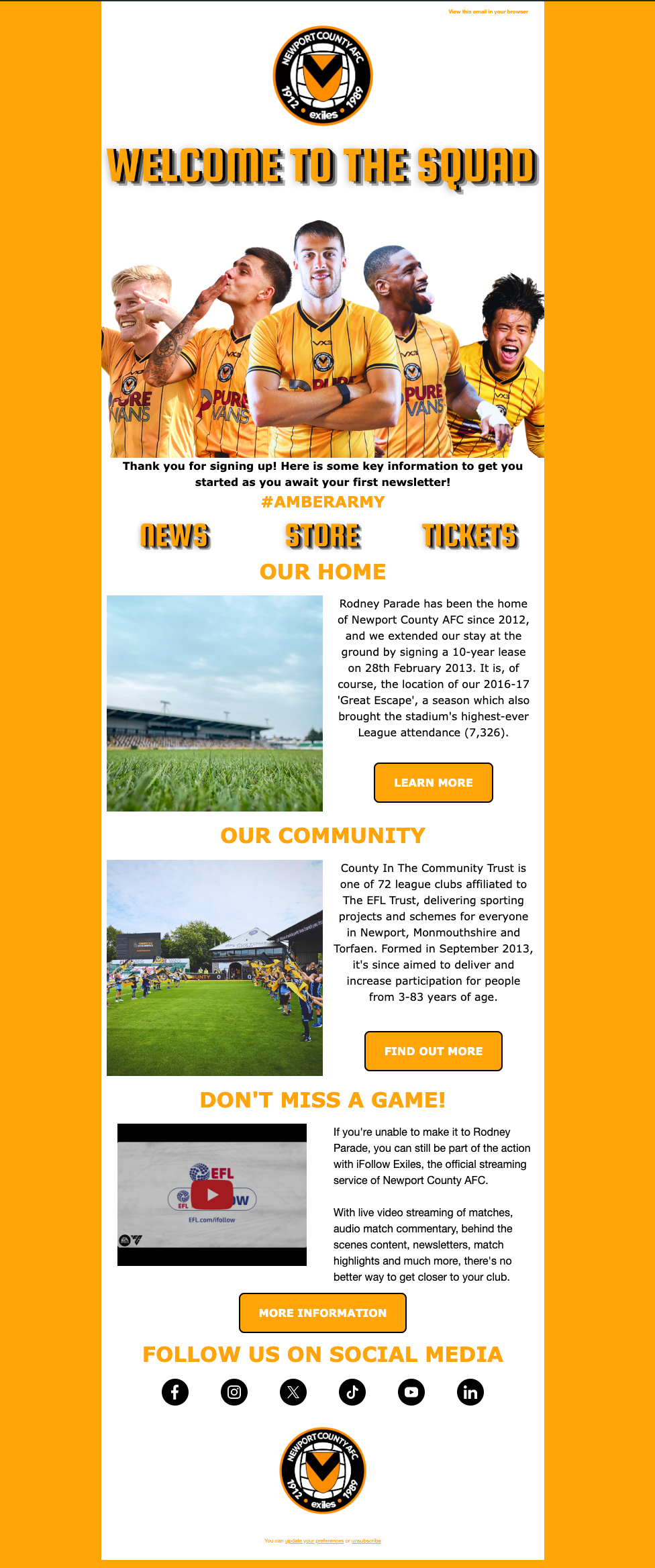
There's nothing groundbreaking, but it gives you a nice welcome message and lets you know this is just a bit of background before the proper emails start.
It's probably not a huge shock to see who features in Wrexham's welcome email.

In this case the club are showing that they know their audience well. They've no doubt recognised that the bulk of their new subscribers have arrived in recent years, and they're leaning into that star power.
Finally, two of my favourites.
Here's how Bournemouth welcomed me.
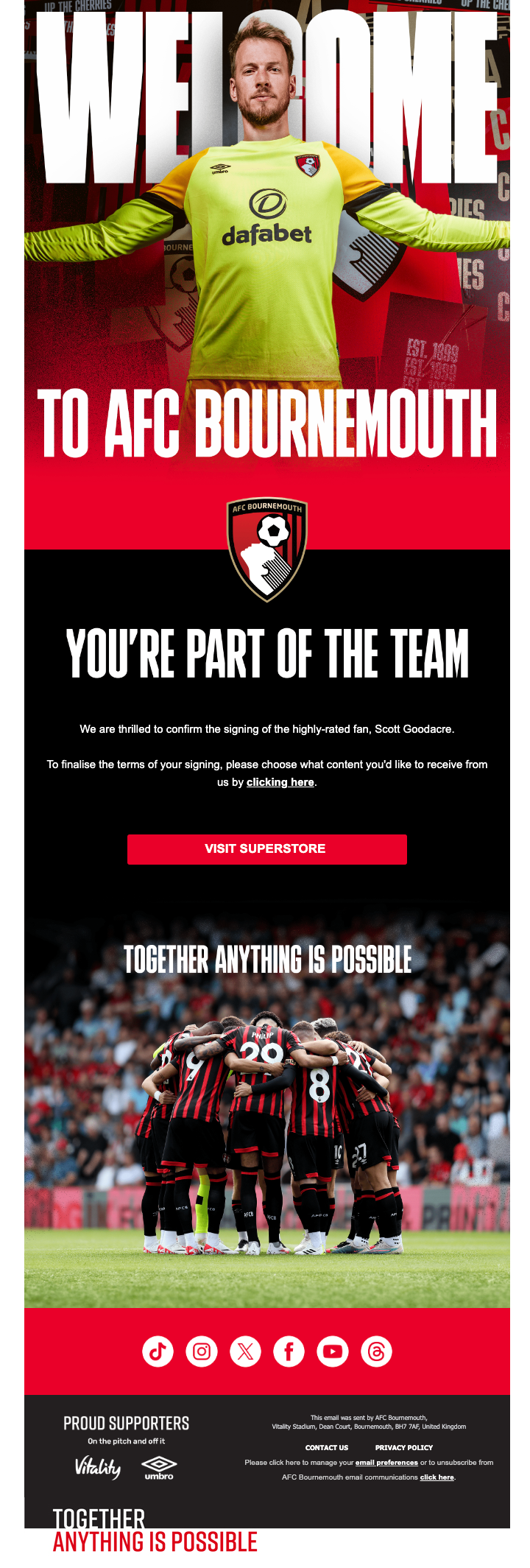
I love the "part of the team" language - pushing togetherness and community - but the added personalisation written in the style of a press release is a very good touch. I don't think I've ever been called "highly-rated" before. And rather than a dull "confirm what you want to receive" message, they've called it finalising "the terms of your signing".
Speaking of personalisation, take a look at this from Wolves.
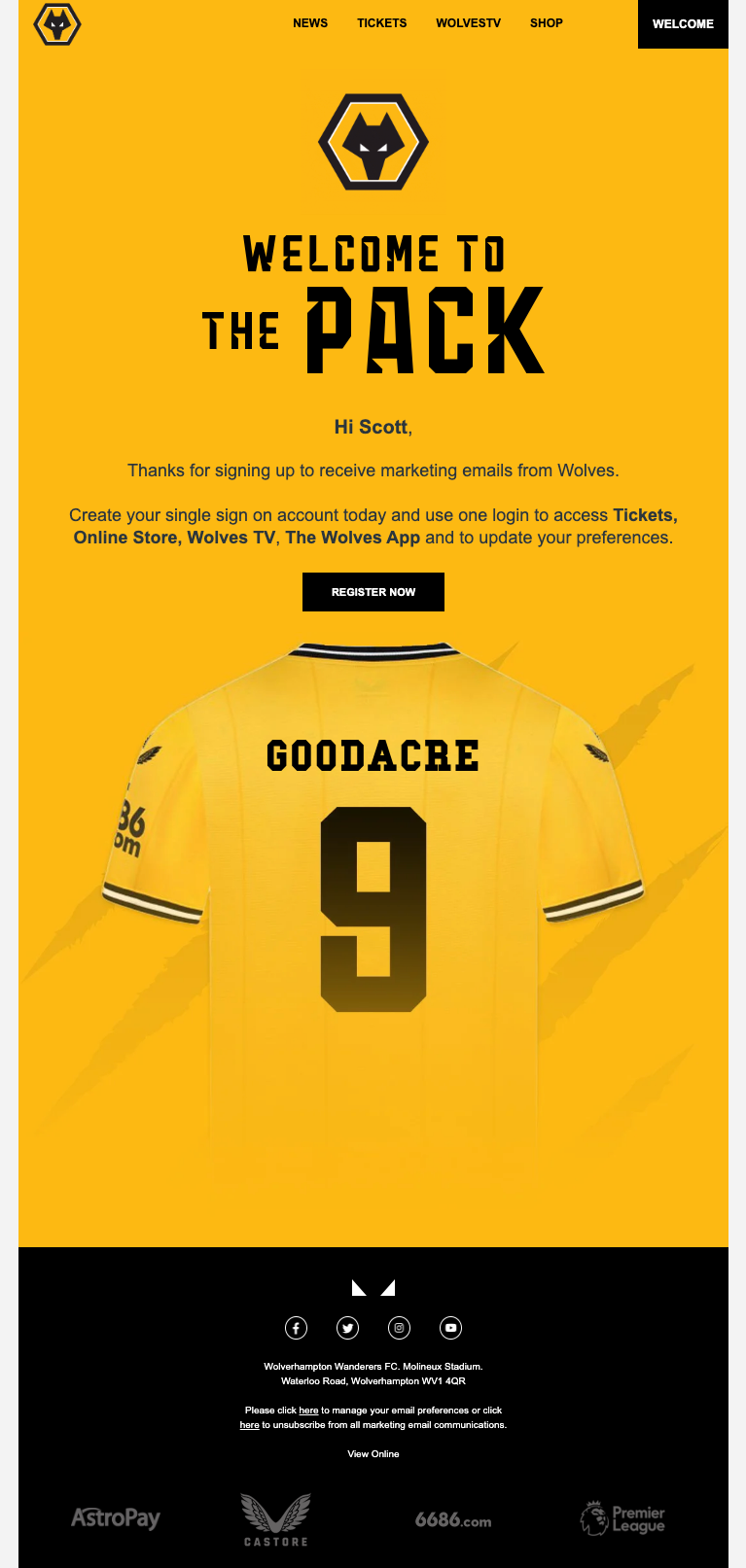
Wonderfully on-brand language ("pack"), my first name, and my very own personalised Wolves shirt. Shut up and take my money.
How do you get started with email marketing?
There are a number of tools and platforms you can use to help you manage an email marketing list. A lot of EFL clubs use the newsletter feature built into the standard template I looked at in the introduction to this. But there are other solutions you can use as you plan for next season. These include:
- Active Campaign.
- Benchmark.
- Constant Contact.
- Dotdigital.
- Klaviyo.
- Mailchimp.
Some of these have free tiers to get you started, and they scale in price depending on how many subscribers you have and how many emails you want to send. That's one of the main considerations you need when making a decision.
The other things to think about are:
- Are there any automation options? Such as sending out a welcome email, or a series of emails.
- Does it offer email personalisation? Ideally you want to be including subscriber names as a minimum.
- How easy is it to create emails? Some platforms have drag and drop editors which make email creation easy. Some need you to know some elements of coding.
- Does it integrate easily with other platforms? In an ideal world you'll tie your emails into ticketing and other online accounts so that information carries over.
- Are there any additional features? You might want to add-on SMS messaging further down the line, for example.
- Reporting figures. You want to know open and click rates as a minimum, and the ability to do things such as UTM tracking is definitely useful.
- Customisable and embeddable forms. This allows you to choose the information subscribers have to submit, as well as adding the form easily to your existing website.
And all of this is before you get round to actually sending anything out.
In a future edition I'll look at the emails that I've received from clubs and analyse them for best practices. I touched on how the Bundesliga and MLS do this before Christmas, but I'll have a club-specific approach for you once I've started getting updates through.
